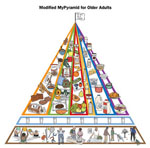Modified MyPyramid for Older Adults
Tufts Researchers Update Their Food Guide Pyramid for Older Adults
BOSTON (December 20, 2007) — Tufts University researchers have updated their Food Guide Pyramid for Older Adults to correspond with the new USDA food pyramid, now known as MyPyramid. The Tufts version is specifically designed for older adults and has changed in appearance and content. The Modified MyPyramid for Older Adults continues to emphasize nutrient-dense food choices and the importance of fluid balance, but has added additional guidance about forms of foods that could best meet the unique needs of older adults and about the importance of regular physical activity.

"Adults over the age of 70 have unique dietary needs"
"Adults over the age of 70 have unique dietary needs," says first author Alice H. Lichtenstein, D. Sc., director of the Cardiovascular Nutrition Laboratory at the Jean Mayer USDA Human Nutrition Research Center on Aging at Tufts (USDA HNRCA). "Older adults tend to need fewer calories as they age because they are not as physically active as they once were and their metabolic rates slow down. Nevertheless, their bodies still require the same or higher levels of nutrients for optimal health outcomes. The Modified MyPyramid for Older Adults is intended to be used for general guidance in print form or as a supplement to the MyPyramid computer-based program."
In 2005, the USDA debuted MyPyramid, an Internet-based program capable of dispensing individualized dietary guidance based on sex, age, height, weight, and exercise habits. Lichtenstein and colleagues were concerned about computer use among older adults and the adaptability of MyPyramid to print form. The Modified MyPyramid for Older Adults is available as a graphic print-out with icons representing foods in the following categories, and fluid and physical activity:
- Whole, enriched, and fortified grains and cereals such as brown rice and 100% whole wheat bread.
- Bright-colored vegetables such as carrots and broccoli.
- Deep-colored fruit such as berries and melon.
- Low- and non-fat dairy products such as yogurt and low-lactose milk.
- Dry beans and nuts, fish, poultry, lean meat and eggs.
- Liquid vegetable oils and soft spreads low in saturated and trans fat.
- Fluid intake.
- Physical activity such as walking, house work and yard work
Published in January, 2008 issue of Journal of Nutrition
The Modified MyPyramid for Older Adults will be published in the January 2008 issue of the Journal of Nutrition. Added to the new pyramid is a foundation depicting physical activities characteristic of older adults, such as walking, yard work and swimming. "Regular physical activity is linked to reduced risk of chronic disease and lower body weights. Government statistics indicate that obesity in adults 70 years and older has been increasing. Physical activity is one way to avoid weight gain in later years and its adverse consequences," says Lichtenstein, also the Stanley N. Gershoff Professor at Tufts University's Friedman School of Nutrition Science and Policy. "In addition, regular physical activity can improve quality of life for older adults."
Emphasized in the Modified MyPyramid for Older Adults are icons depicting packaged fruits and vegetables in addition to fresh examples, forms that for a number of reasons may be more appropriate for older adults. These include, for example, bags of frozen pre-cut vegetables that can be resealed or single-serve portions of canned fruit. "These choices are easier to prepare and have a longer shelf life, minimizing waste. Such factors are important to consider when arthritis kicks in or dark, cold days mean it is less likely someone will go out to replenish their refrigerator stores," Lichtenstein says.
Fiber is important
"We continue to emphasize the importance of consuming adequate amounts of fiber rich foods, which means choosing mainly whole grain products rather than highly refined forms, and whole fruits and vegetables rather than juices. The Modified MyPyramid for Older Adults is replete in good examples," Lichtenstein says. "Fresh, frozen, canned and dried fruits and vegetables are excellent sources of fiber, as well as a whole host of other nutrients. The increased availability of whole grain products lowers the barrier on making those choices."
More Water
The Modified MyPyramid for Older Adults stresses the importance of consuming fluids by having a row of glasses as its foundation. "As we age there can be a disassociation between how hydrated our bodies are and how thirsty we feel, this can be particularly of concern in the summer months," Lichtenstein says. The authors note food and beverages with high water content, such as lettuce, vegetable juice and soups, are important contributors of fluid in an older person's diet.
More Vitamins
Also included as an integral part of the Modified MyPyramid for Older Adults is a flag at the top suggesting that older adults may need certain supplemental nutrients. "The need for calcium, vitamin D and vitamin B12 can increase as we age and some people find it difficult to get adequate amounts from food alone, especially when calorie needs go down," Lichtenstein says. "The flag at the top of the Modified MyPyramid for Older Adults serves as a reminder that some people may need to discuss this potential need with their health care providers. However, we continue to emphasize that the majority, if not all, of nutrients an older adult consumes should come from food rather than supplements."
The original Food Guide Pyramid for Older Adults, published by Tufts researchers in 1999, is widely used as an illustration in textbooks and manuals, featured in newsletters for older Americans, and in informational material prepared by the Departments of Elder Affairs in a number of states. Now that the USDA's Food Guide Pyramid has been redesigned to be computer based, the Tufts researchers felt it was important to update their version.
This study was supported by a grant from the Ross Initiative on Aging at Tufts University and the US Department of Agriculture (USDA). Lichtenstein AH, Rasmussen H, Yu WW, Epstein SR, Russell RM. Modified MyPyramid for Older Adults. J Nutr. 2008; 138:78-82.
The Gerald J. and Dorothy R. Friedman School of Nutrition Science and Policy at Tufts University is the only independent school of nutrition in the United States. The school's eight centers, which focus on questions relating to famine, hunger, poverty, and communications, are renowned for the application of scientific research to national and international policy. For two decades, the Jean Mayer USDA Human Nutrition Research Center on Aging at Tufts University has studied the relationship between good nutrition and good health in aging populations. Tufts research scientists work with federal agencies to establish the USDA Dietary Guidelines, the Dietary Reference Intakes, and other significant public policies.
|
|


